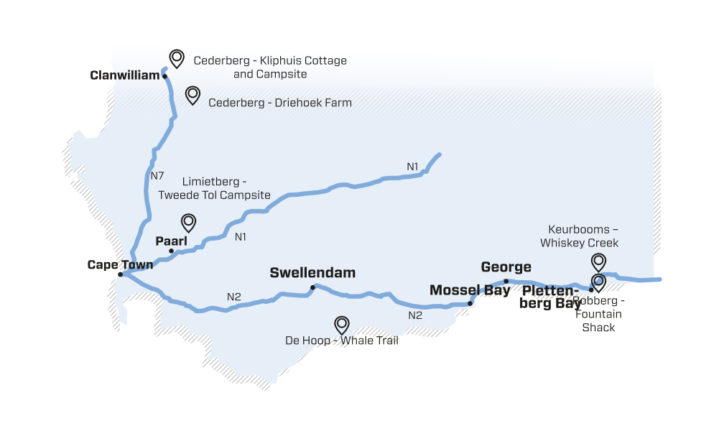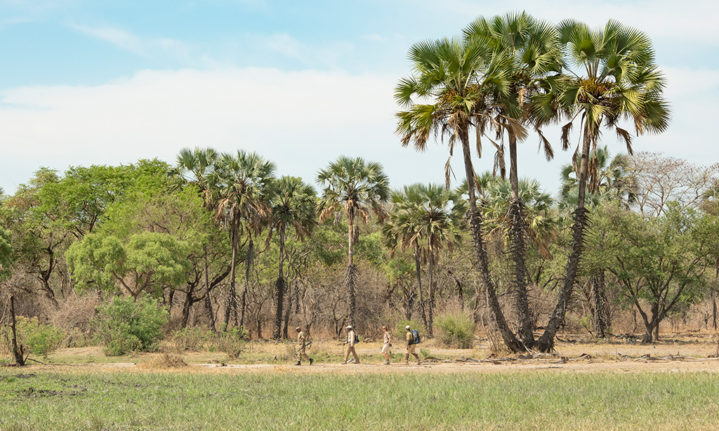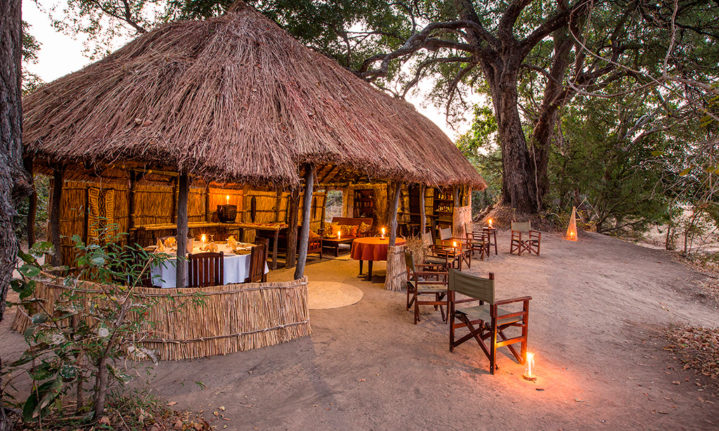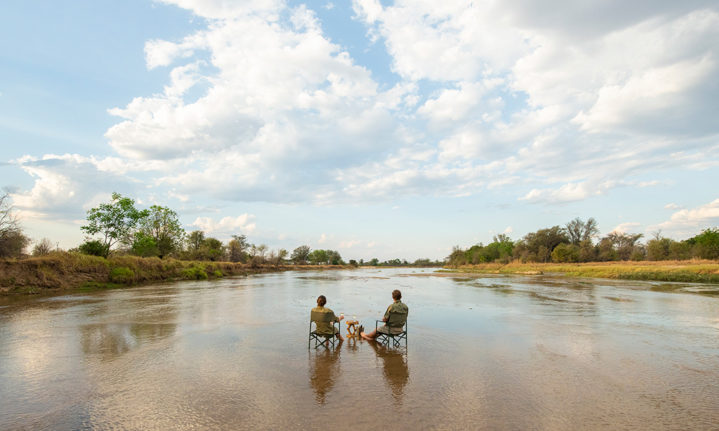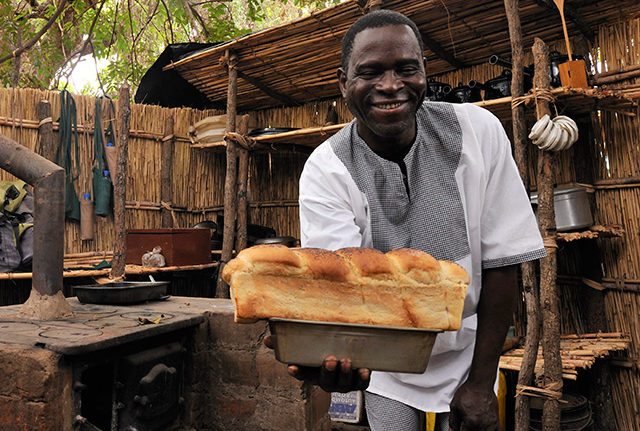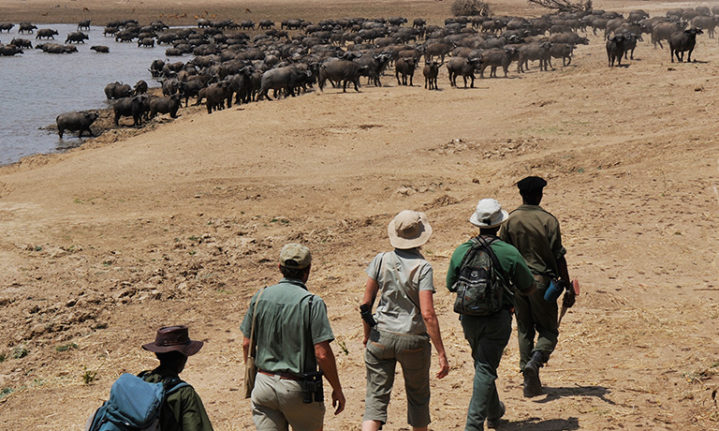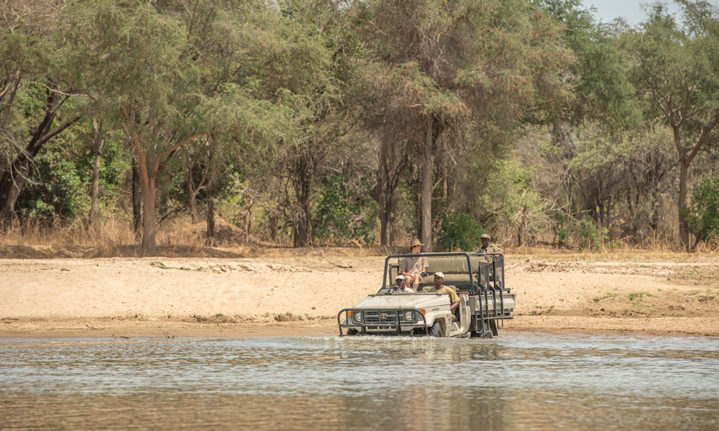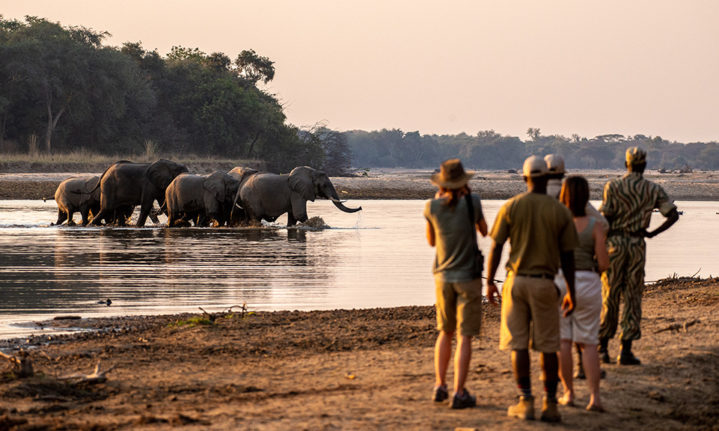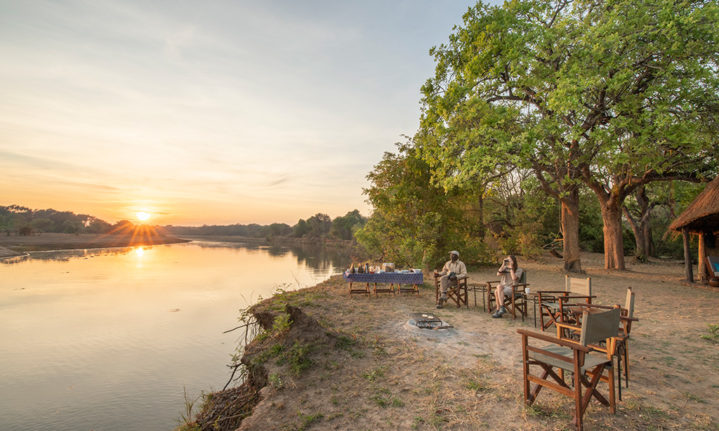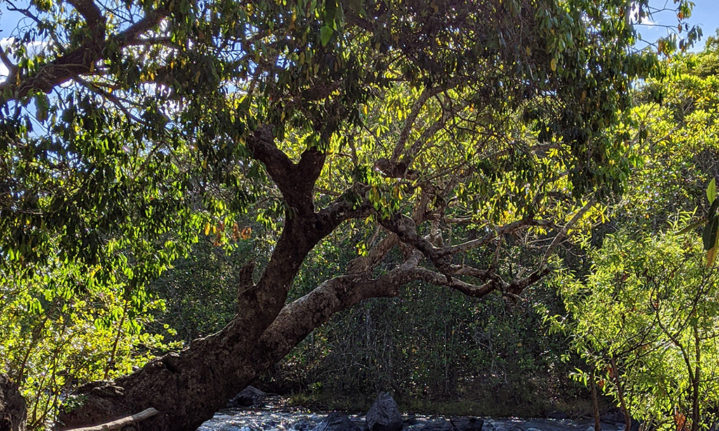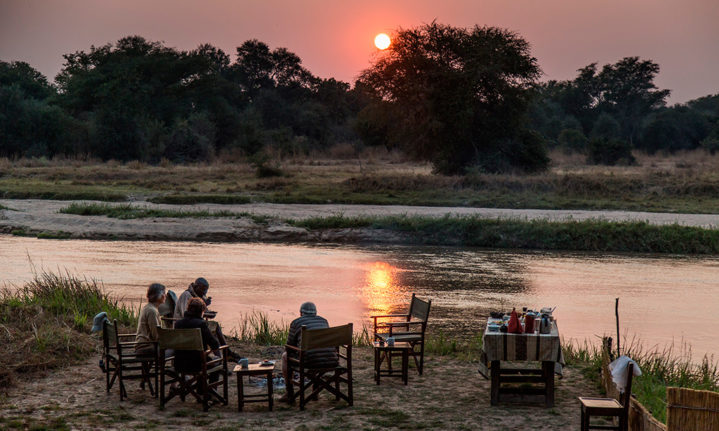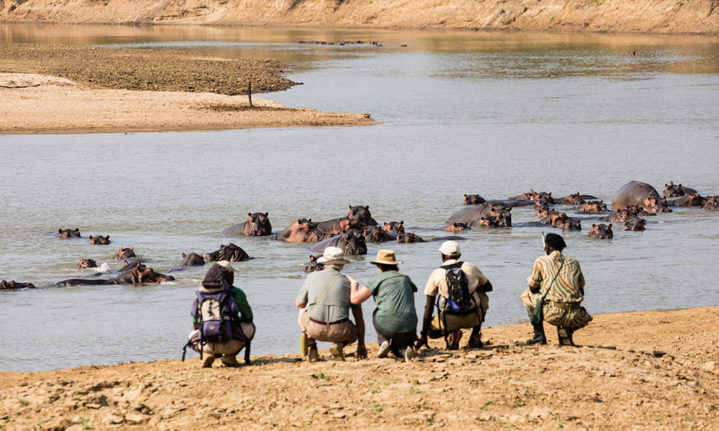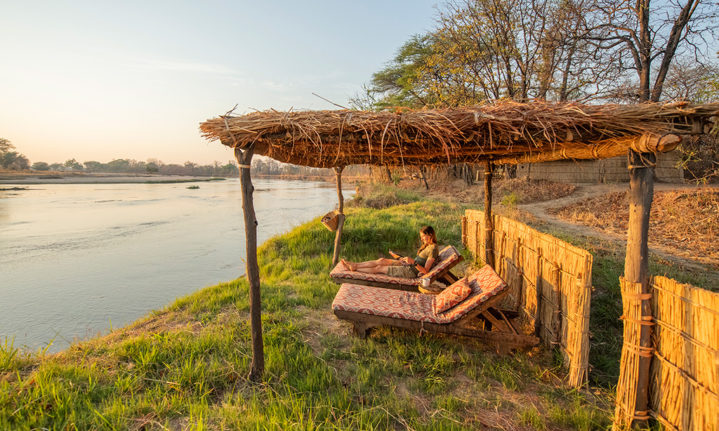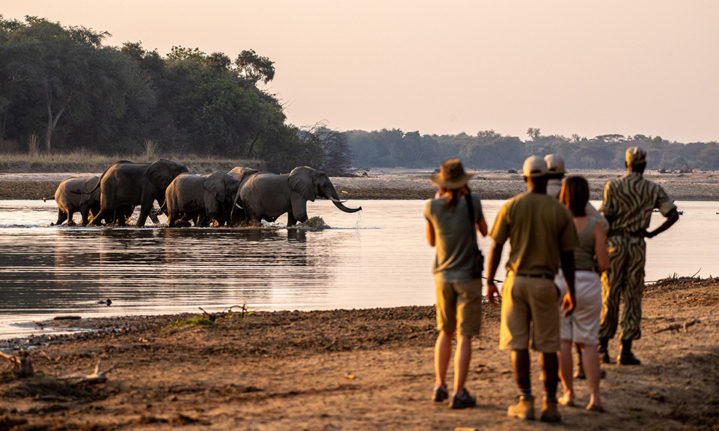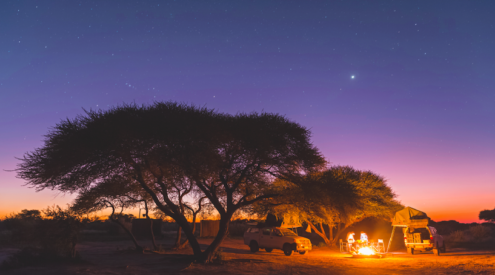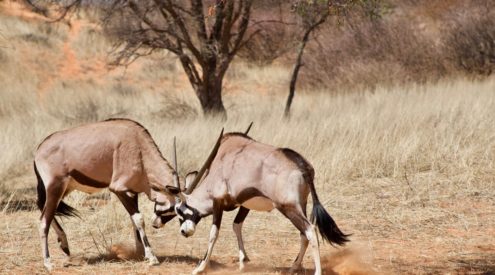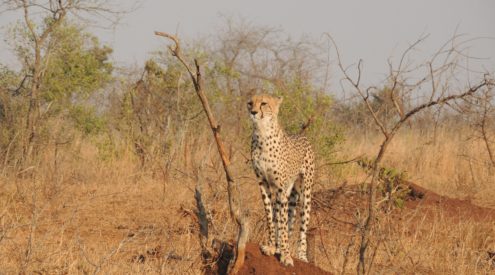North Luangwa National Park in Zambia is remote and completely inaccessible in the wet season. With few roads – and fewer people – it offers one of the wildest bush-walking experiences you’ll have anywhere in Africa. A Zambian local leads the way.
Words: Sarah Kingdom
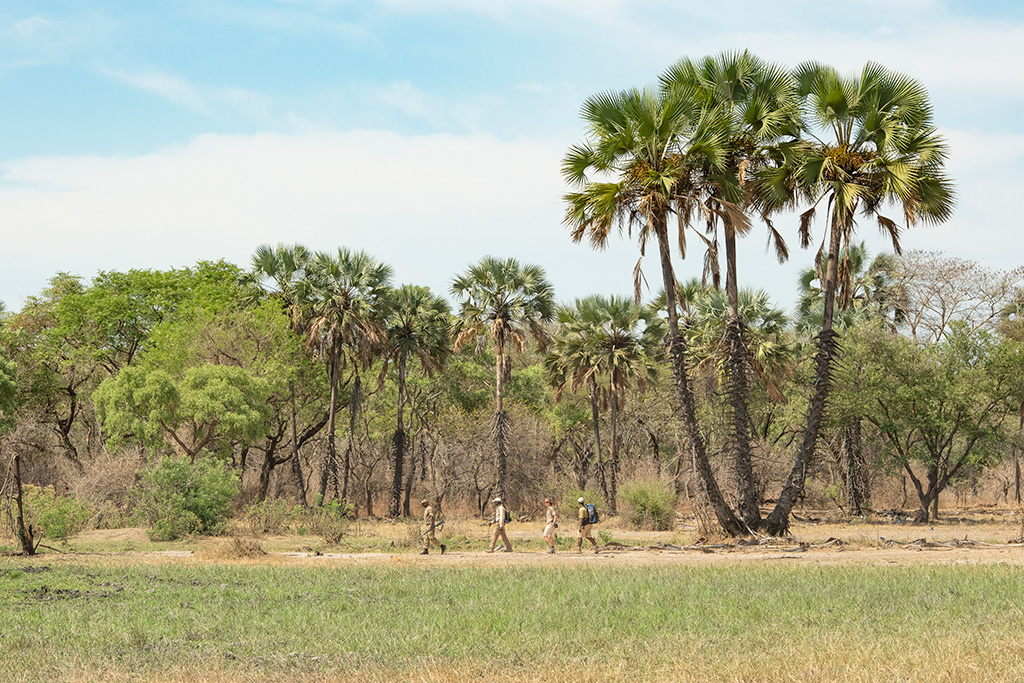
North Luangwa has few roads, so walking is the only way to explore its nooks and crannies.
I’m lying on my stomach in the shallow water of the Mwaleshi River, in the heart of Zambia’s North Luangwa National Park. I have two small boys in the water with me, both of whom are pretending to be bulldozers and attempting to bury me with river sand. On the bank above, our vigilant, armed game scout calls down to us and points out a magnificent male lion, at a bend in the river, a few hundred metres away. The two little boys and I stand up, the lion pauses midstream, stares in our direction and we stare back. After giving us a piercing look, he continues crossing to the opposite bank. Exiting the water, we clamber up the sandy bank and set off on foot, hoping to find the rest of the pride. Around the bend we see them, feasting on a buffalo carcass that has tumbled down the steep bank, wedging itself in a bush just above the waterline.
The Great Rift Valley extends south into the northeast of the country and it is here that the Luangwa River, a tributary of the Zambezi, has carved out an incredible landscape. North Park, as it is commonly called, is a remote, wild world. Roads are few, vehicles even fewer, visitors barely register on the radar. For those who do venture here, 4 636km2 of untamed raw wilderness await, and are best explored on foot. You are unlikely to see any other visitors the entire time you are in the park.
My husband and I were on one of several self-drive trips we’ve made from our farm in Mkushi, in Zambia’s Central Province into North Luangwa. This time we were joined for part of the trip by friends with their two boys, aged two and five.
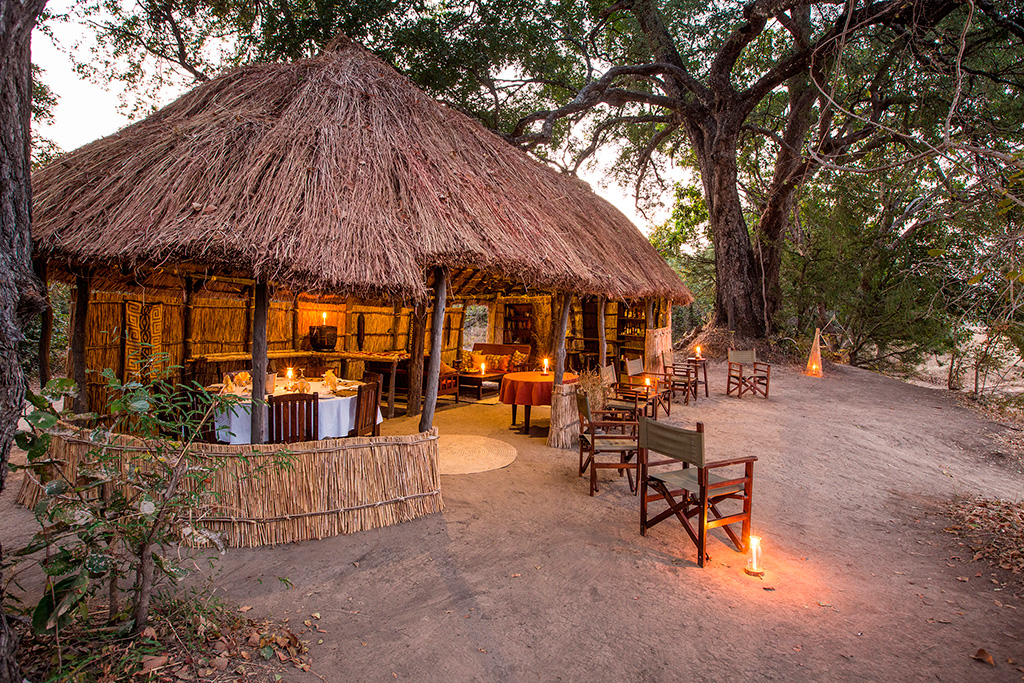
Massive trees shade the bar and dining area at Mwaleshi
Our first stop was Samala Camp, just outside the park and close to Mano Gate (the north-western entrance to the park). This beautiful camp is on the banks of the Mwaleshi River, the lifeblood of the park. Samala consists of a pair (soon to be a few more added) of spacious permanent, ensuite tents, a well accessorised kitchen and a combined dining, lounge and braai area near the river. There’s also a beautiful campsite downstream, with soft mossy ground and a pretty tree canopy above.
At Samala the river is rocky, cool, narrow and fast; gurgling over the rapids with a sound that lulls you to sleep at night. In the morning you wake to a chorus of birds all competing to make themselves heard over the sound of the water, as you nurse your coffee by the fire. Despite being outside the park there are plenty of signs of wildlife here. Walking downstream we found piles of white poop, the telltale sign of hyena. Along the river, where it widens into pools, hippo footprints were pressed deep into the soft mud. Rounding a corner we almost stumbled upon a pair of elephants, tearing branches off trees and fortunately concentrating so intently on their meal that they didn’t seem to see us… we quietly reversed at speed.
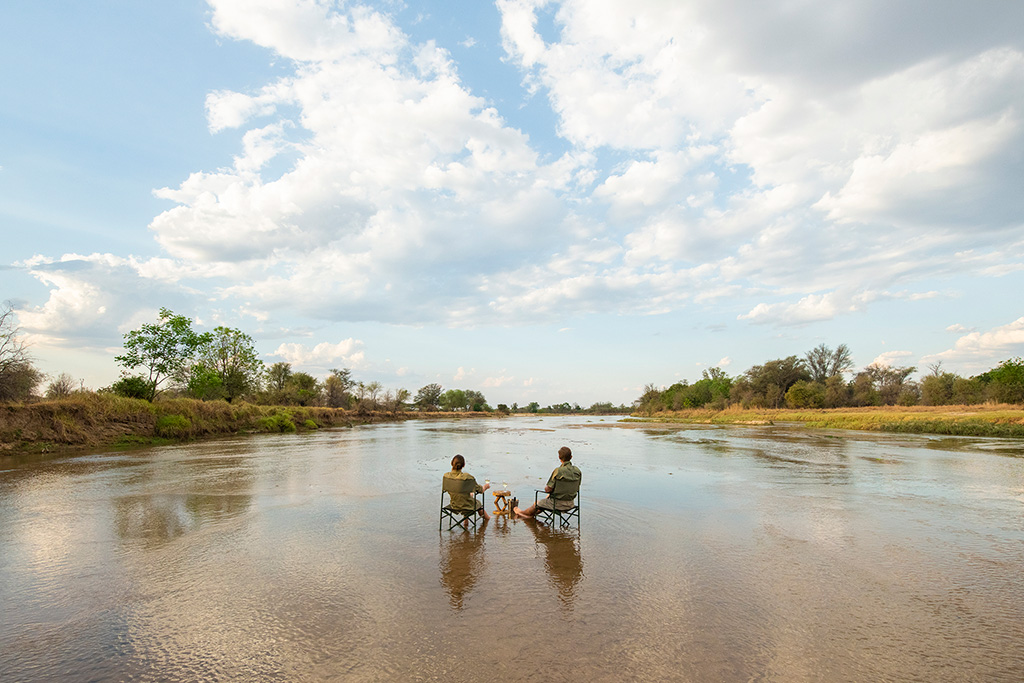
After a long bush walk the shallow, cool water of the Mwaleshi River is the perfect balm for tired feet.
Leaving Samala through the Mano Gate, we descended the dramatic Muchinga Escarpment and into the park. A walking safari in North Luangwa is the ultimate way to experience this remote place and we were heading for Mwaleshi Camp to enjoy a few days of walking. The bush is very different when experienced on foot; you are conscious of every rustle in the undergrowth and every twig snapping underfoot. The alarm calls of pukus and baboons and the occasional roar of a lion, or trumpet of an elephant, keep you aware of your surroundings. A walking safari teaches you to enjoy the little stuff – animal tracks, the scents of the bush, the tiny flowers and insects.
Unrecognisable from the fast, loud and rocky stream at Samala, when we reached Mwaleshi Camp the river had widened considerably, becoming slow and sandy. To minimise impact on the park, the reed-walled rooms at Mwaleshi are rebuilt afresh every year. The main building has a small lounge, bar and dining area, and not a single nail has been used in its construction. The chef is an expert at producing terrific meals with just a cast iron stove, an earth oven and an open fire.
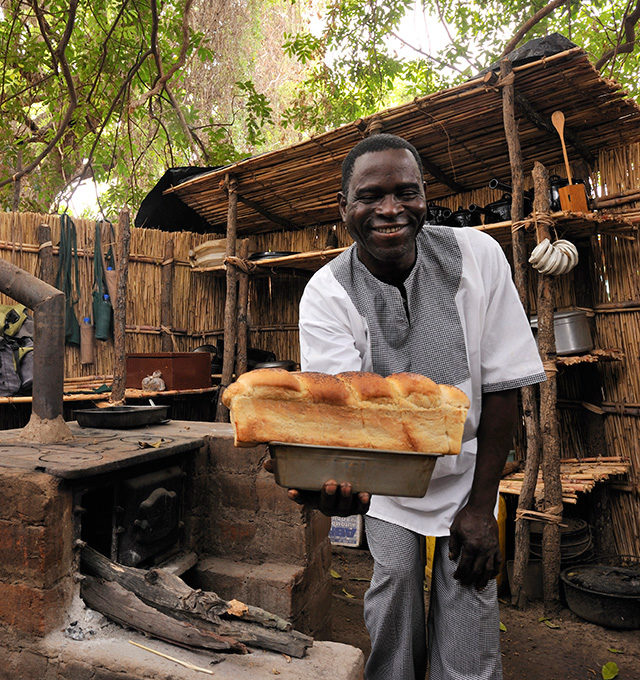
North Luangwa is famous for its huge herds of buffalo.
Walking out from Mwaleshi that afternoon, the air was heavy with the scent of Natal mahogany blossom. For three hours we headed through long grass, across rivers, ducking under branches, pausing to untangle ourselves from thorn bushes. The Luangwa Valley is a great place for birding – approximately 400 species are recorded here – and we witnessed all kinds of swooping, aerial displays and airborne aerobatics from myriad flyers as they hunted insects.
That night in camp was one of those real Out of Africa experiences. Shower water heated over a fire, sundowners in easy chairs, as sunset turned the water to orange and scarlet liquid silk. Dinner was true safari style: wine and a three-course candlelit meal on the banks of the river with prides of lions roaring on all sides. Mysterious splashing noises sounded in the river as animals waded through the water in the dark.
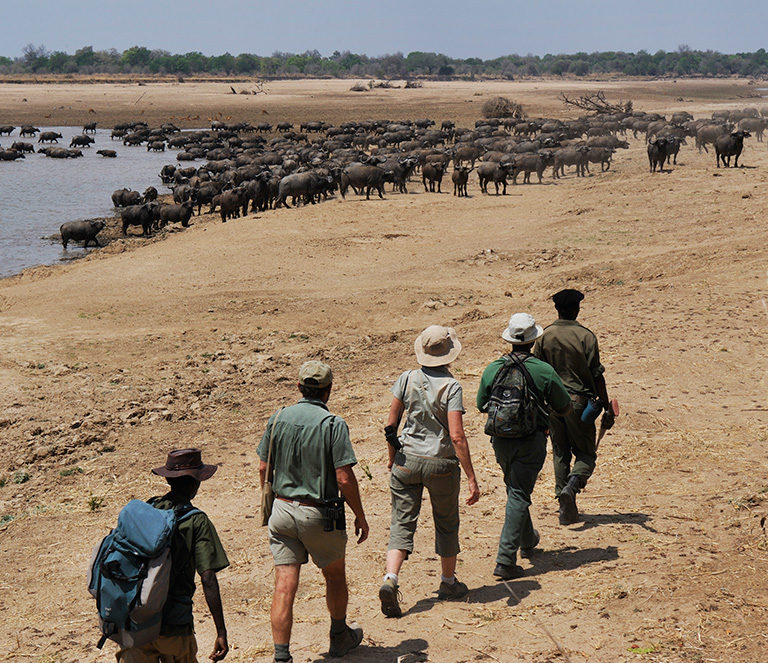
Amazing fare emerges from the rustic kitchen at Mwaleshi.
A typical day in North Luangwa starts at about 5am. A quick wash, coffee and breakfast around the campfire, then we set off for what would be a five-hour walk, crossing the surprisingly chilly, Mwaleshi River, while our eyes adjusted to the growing light. A bull elephant walked along the bank. We followed from a distance. He started across the river until he smelt us. Stopping, his ears waved wildly and his trunk went up scenting the air. Deciding we didn’t pose much of a threat, he continued across the river, vanishing into the thick vegetation on the other side of the Mwaleshi.
Three hours’ walk (or a one-hour drive) downstream from Mwaleshi Camp is Takwela, located in the Game Management Area on the opposite side of the river from the park. Sheltered among African ebony, mahogany, winterthorne, sausage trees and the occasional Ilala palm, the camp is perched several metres above the water. Four spacious, thatched rooms are spread along the river bank, with views across to the national park beyond. It’s located at the confluence of the Mwaleshi and Luangwa rivers, and a necklace of 50 or more grumpy, resident hippos stretches across the water in front of camp, only metres from the dining room and lounge.
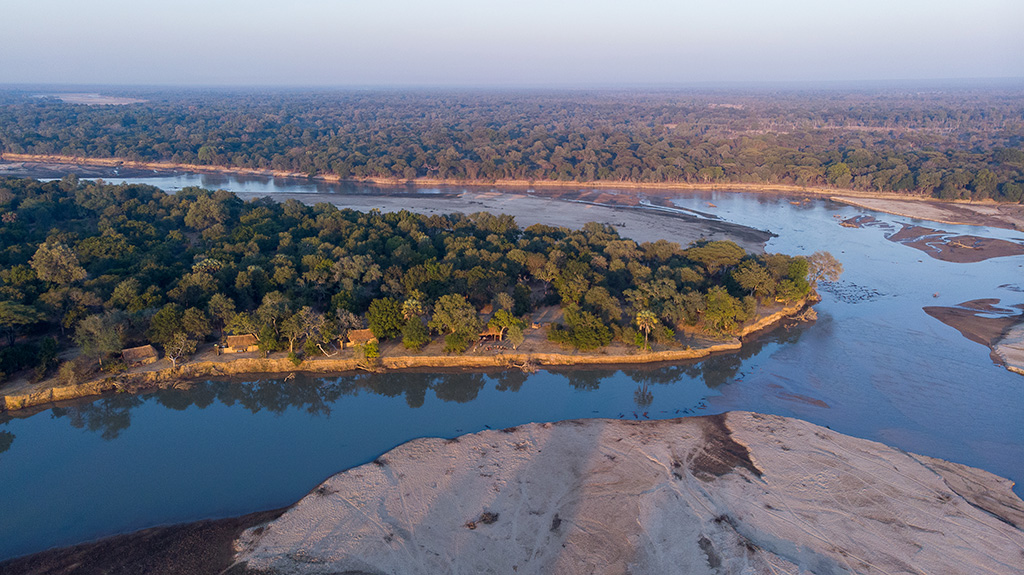
Bird’s-eye view of Takwela Camp where the Mwaleshi and Luangwa rivers converge.
In the mornings we would paddle across the river in canoes and set off on foot into the park. We followed the tracks of leopard and hyena; found a pair of lions resting in the shade of a mahogany tree. In the sand we saw the swish marks of crocodile tails, the scrape marks of hippo chin bristles, elephant footprints large and small and indentations of zebra hooves in the damp river sand. We were completely immersed in the bush.
About 20km from Takwela, across the Luangwa River and back inside the park, is North Luangwa River Lodge & Camp. On the banks of the river and in an ancient grove of Leadwood trees, the thatched bungalows are interconnected by raised wooden decking, giving beautiful views over the river below. Every evening in camp we would sit on the deck, under the branches of a huge sausage tree, watching the sun go down. A family of elephants often came down to the water nearby for their own version of sundowners and as darkness came, a huge orange moon would rise in the sky.
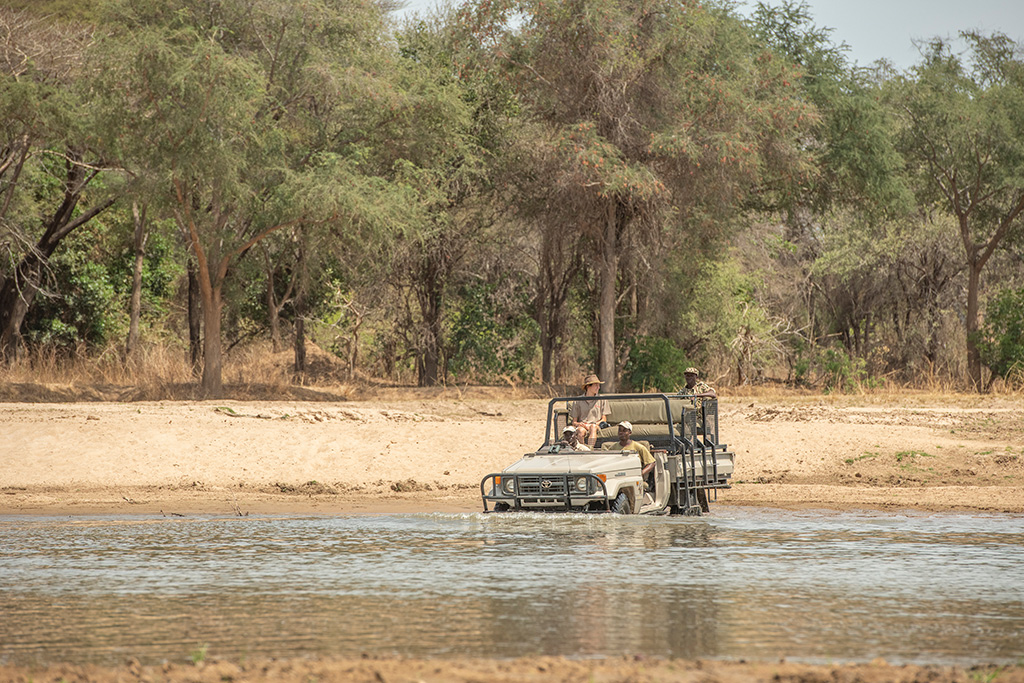
It’s quite an experience returning to camp after a game drive in the park– and this is the dry season!
Lying in bed at night, a bush orchestra serenaded us to sleep and in the mornings we would sit in our pyjamas on our veranda, coffee in hand, watching the spectacular colours of sunrise. Walking out with our scout one morning, not long after sunrise, we were hot on the heels of lions. We followed their tracks but never caught up with them. Black rhino tracks in the sand at the river’s edge had us excited and we spotted the game scouts whose job it is to protect the rhino who have been successfully reintroduced into the park but the rhino themselves proved elusive.
Days later, as we left the park for home, we rounded the bend and found a sight North Luangwa is famous for: a huge herd of buffalo, numbering in their hundreds, streaming across the track. It was the perfect end to this visit.
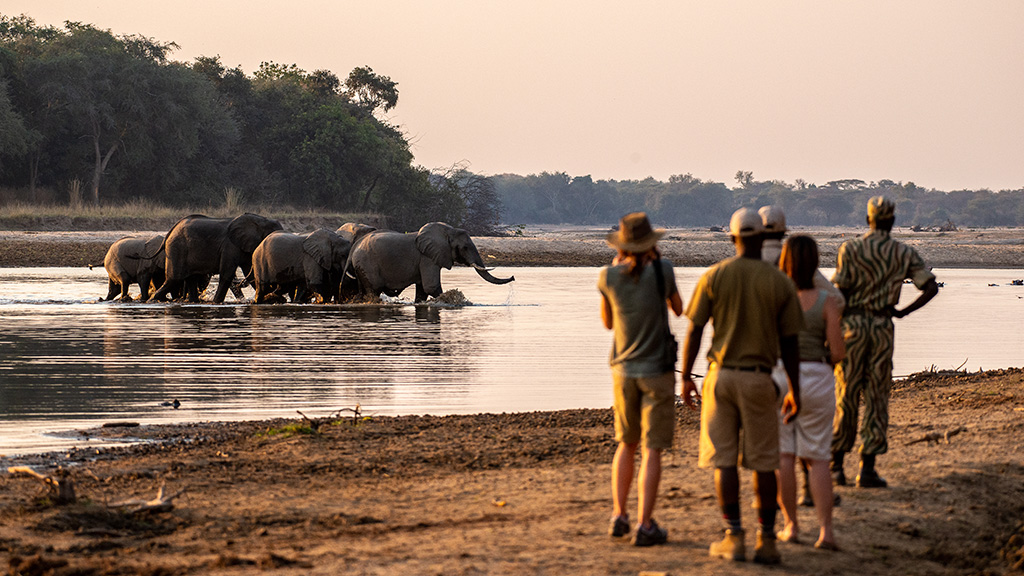
Sundowners as dinner is prepared at Takwela.
While you’re in the ‘hood
From Samala Camp there are a couple of lovely day trips to waterfalls. There’s Kapamba Falls, a spectacular waterfall with beautiful views of the Luangwa Valley while Lufila Falls is on the Lufila River on the northern boundary of the national park.
Other destinations that could be incorporated into a self-drive trip to North Luangwa are Kasanka National Park, Shiwa Ng’andu (the colonial estate of Stuart Gore Browne, and the subject of the fascinating The Africa House biography by Christina Lamb), Kapishya Hot Springs, Luambe National Park and South Luangwa National Park.
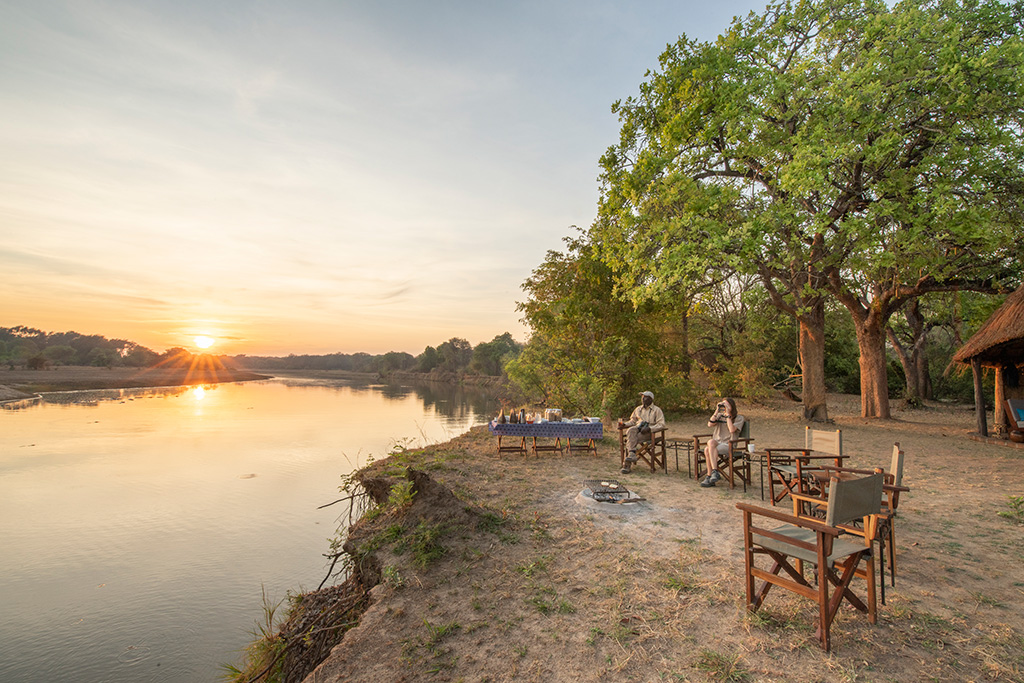
All the lodges in North Luangwa have excellent guides while the park itself has well-trained and dedicated game scouts.
Rhino reintroduction
Poaching led to the decimation of rhinos in Zambia by 1998. A reintroduction project began in 2003 and five black rhinos were introduced into an ‘intensive protection zone’ in the heart of North Luangwa. By 2010, 25 had been translocated. North Luangwa is now home to Zambia’s only black rhinos.
Partnership
Established in 1972, the park is now run by North Luangwa Conservation Programme, a partnership between the Frankfurt Zoological Society and the Zambian Department of National Parks and Wildlife.
Access
North Luangwa is only accessible by light aircraft or with a 4×4 and is only open in the dry season, from June to October.
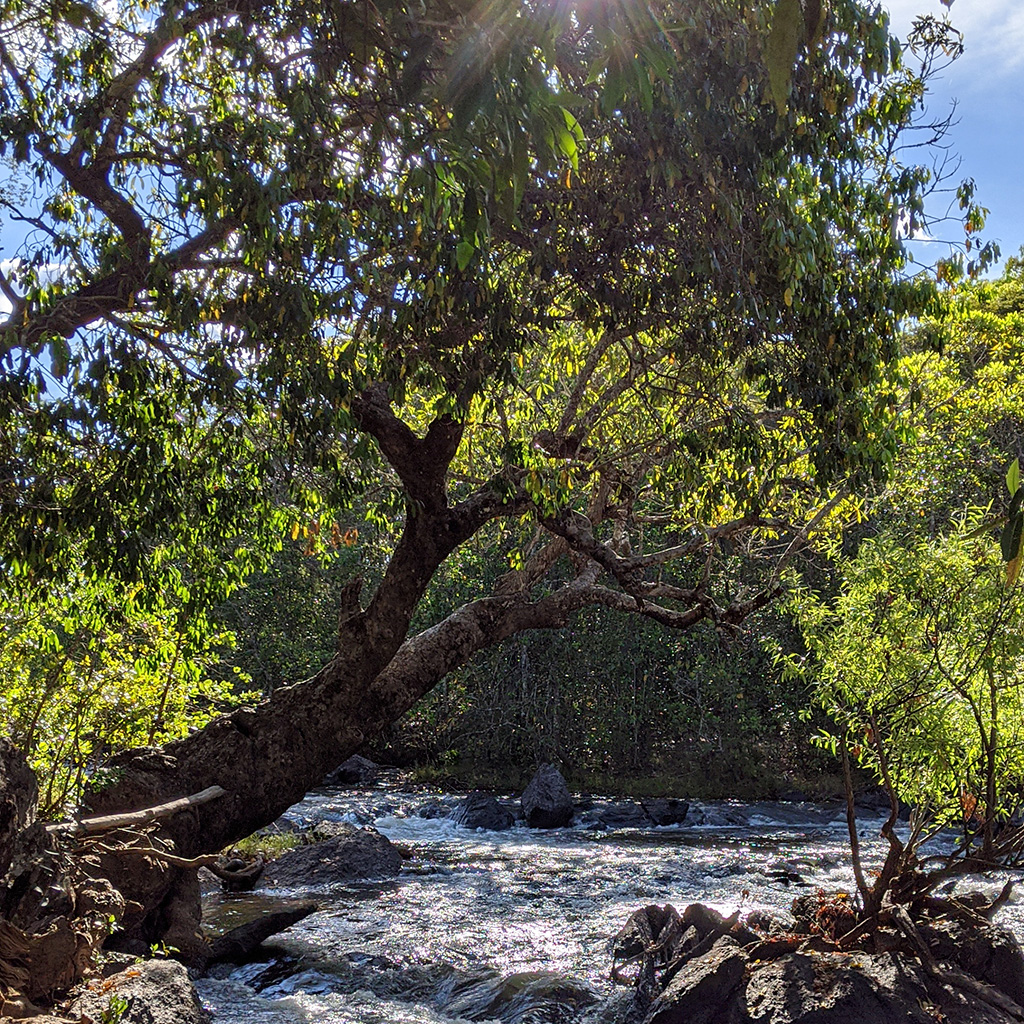
At Samala the Mwaleshi River is a bubbling, fast-flowing stream.

Trip Planner
Getting There
From Mpika it’s 95km to Mano Gate. Turn east off the Great North Road 62km north of Mpika at Lwanya village (Chitembo on Google Maps), signposted 42km to Samala Camp. 4×4 vehicles recommended. It’s 3km from Mano Gate to Samala, 40km to Mwaleshi Camp, and 60km to North Luangwa River Lodge. If you are approaching the park from the south, Chifunda Pontoon is 180km from Mfuwe Bridge via Luambe National Park; it’s 60km to Mano Gate via the pontoon road that runs through the middle of the park.
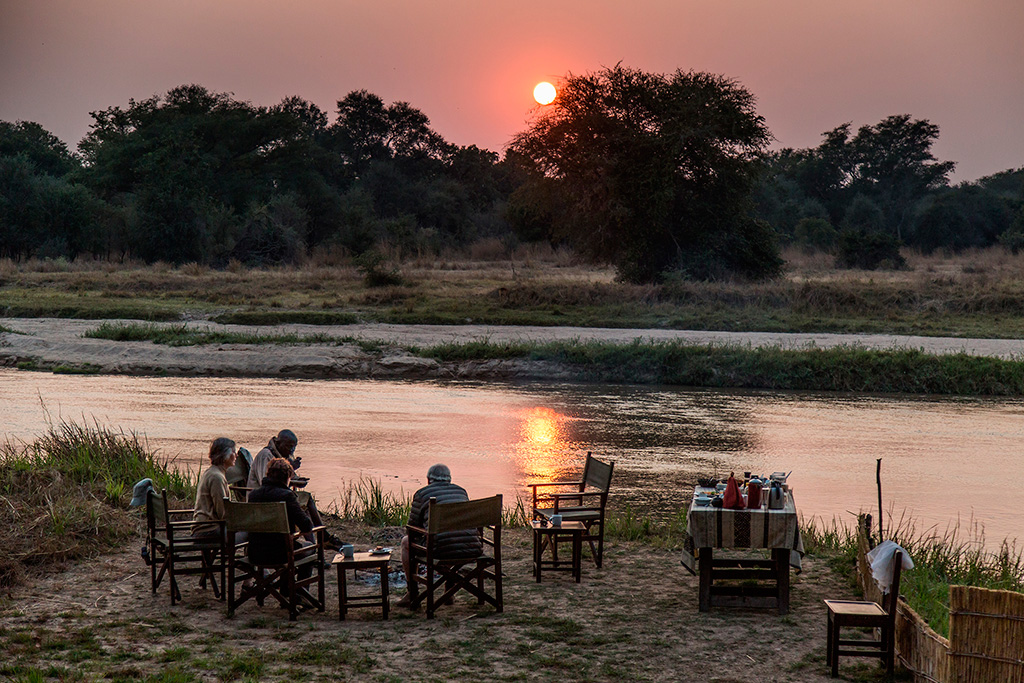
By the time it reaches Mwaleshi Camp 40km downstream it’s completely chilled – in this setting who or what wouldn’t be?
Stay Here
Ituba Camp is self catering. They have upgraded to a four ensuite walk in Safari Tents with self-catering facilities. It has three camp sites with toilets and showers. The rates are for the Safari Tents – US$25/pp/pn and camping – US$ 10/pp.
Mwaleshi & Takwela Camps
Mwaleshi is a seasonal bush camp; the comfortable rooms are reed mat constructions with bucket showers on demand. Takwela is a more permanent camp, built with brick, thatch and timber, bathrooms are open to the sky and showers have views over the river. SADC rate is $455 pp full board. [email protected]
remoteafrica.com/mwaleshi-camp/

Mwaleshi Camp
North Luangwa River Lodge Four rooms built on stilts and joined by wooden decking make up the bedrooms; there is a separate and spacious dining, bar, lounge and deck area. SADC rate is $130pp in bungalows for self-catering but with use of the camp chef; $35pp/pn for camping; full board is $290pp/pn
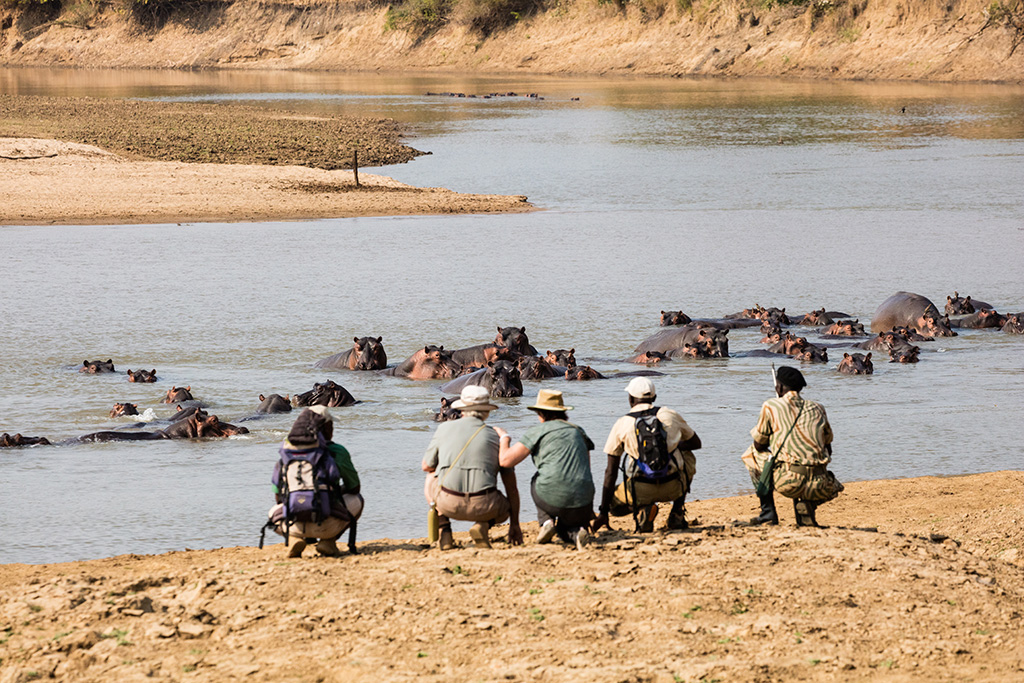
The hippo populations in the Luangwa Valley are probably the densest in Africa, and the sound of their squabbles is a constant background at Takwela and North Luangwa River Lodge.
[email protected]
luangwaexplorers.com/
ALSO READ









